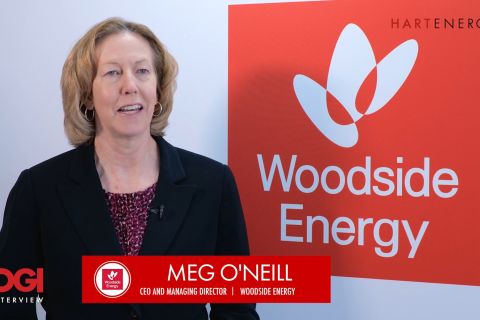
Although the days of lease and flip are over for the foreseeable future, RBC Richardson Barr Managing Director Craig Lande said “it doesn’t mean all hope is lost. It’s just about revising the game plan and resetting expectations.” (Source: Hart Energy/Shutterstock.com)
Learn more about Hart Energy Conferences
Get our latest conference schedules, updates and insights straight to your inbox.
As crude oil prices continue to hover within the $50 range, energy buyers and lenders are exercising discipline by allocating less capital, which is stymying the M&A deal flow.
Public E&P companies are facing the biggest challenge currently as their stocks have not performed well and lower commodity prices have led to tighter cash flow. Plus, investors increasingly want to see capital discipline from E&P companies and returns on capital already employed—not to layer on more debt or sell more equity, according to Ethan Bellamy, a managing director who covers energy stocks at Baird, a Milwaukee-based investment bank.
“The bonanza days of limitless capital access are over,” Bellamy said. “Self-financing is the key.”
Further, unless the capital markets open up significantly, companies will not be able to grow at any cost, said Brock Hudson, a managing director at Carl Marks Advisors, a New York-based mid-market focused investment banking and advisory firm.
“I have not seen any indication it will improve anytime soon,” Hudson said. “There will be more deal activity, but without the markets opening up a bit, we will end up seeing more stock considerations especially for private-equity-backed companies.”
RBC Richardson Barr Managing Director Craig Lande said constraints in raising public equity through capital markets will be an ongoing catalyst for more corporate consolidation, which will take the form of corporate mergers for companies with attractive assets and operating synergies.
The companies who do not have the cash flow to keep operating and cannot access financing face a tougher road and will have to wait longer to sell themselves or wait for the market to improve. Lande said the companies that are overleveraged, have disparate assets or can’t live within cash flow will face filing for bankruptcy.
“There are some companies that don’t even need to exist,” Hudson also added. “It’s more of a buyer’s market than a seller’s market.”
Companies are facing fewer options now since there are plenty of potential sellers, but not enough buyers, according to Holt Foster, a senior partner in the corporate securities section, private-equity funds and M&A in oil and gas at Thompson Knight.
“In this environment, companies are faced with the risk of selling assets for a lower value than they believe they would receive next year or when the capital markets finally open up,” Foster said. “Their other option is to hold on and further develop their assets until the market rebounds so that sellers can get a true value.”
Resetting Expectations
Potential acquirers are facing difficulties raising capital for deals through the public markets, leading to a significantly smaller number of active purchasers.
Private-equity firms, which have historically been aggressive acquirers when public companies are on the sidelines, are facing challenges of their own, Lande said. These firms are more hesitant in this market when it comes to acquisitions due to the potentially longer investment holds of three to five years compared to one to two years.
“This will force more equity dollars towards existing investments ahead of an exit,” he said. “On the sell-side, there is a substantial amount of private equity dollars tied up in a lot of assets that normally would have sold to a public company aggressively paying for inventory or acreage.”
The oversupply of oil and gas in the U.S. has driven the prices of both commodities down to levels that are unhealthy for the industry, said George McCormick, co-founder and managing partner of Outfitter Energy.
“Modest commodity prices have led to a less than robust excess cash flow, making either type of currency used for acquisitions by public companies expensive and hard to come by,” McCormick said. “This means that many private companies will be looking for capital to continue the development of their assets, as the exit alternative will not be available. This situation sets up nicely for providers of drilling capital, whether it be structured as debt, DrillCos or nonoperating equity participation.”
The market for in-basin, stock-for-stock mergers that increase scale, reduce cost and create synergies will continue to be very active, McCormick said. However, property level acquisition and divestiture activity will remain slow.
Lande added that the current oil prices are a hindrance to more deals in the industry.
“The industry right now doesn’t seem to be fully functioning at $50 oil,” he said. “In order for many private-equity-backed portfolio companies to extend out, they will have to invest in drilling more wells to delineate their position, grow production and hold acreage. This has led many of these companies to explore alternative sources of capital beyond using more of their sponsor’s equity such as DrillCos and other structured products.”
The overall sentiment right now is “pretty gloomy,” Lande said but added some investors believe that are some opportunities for investments.
“Those investors with dry powder feel there is an opportunity to acquire in this environment as valuations have softened significantly and public companies continue to hive off noncore assets and redeploy that capital to core areas,” he said. “There should be ample opportunity in this kind of market for buyers with patient money and proficient operating teams to ultimately capitalize on neglected assets within majors and large independents.”
Although the days of lease and flip are over for the foreseeable future, Lande said: “it doesn’t mean all hope is lost. It’s just about revising the game plan and resetting expectations.”
Types of Financing
Commercial banks have less of an appetite today compared to prior years for E&P lending, Bryan Benoit, partner-in-charge, U.S. Energy-advisory at Grant Thornton, a Chicago-based audit, tax and advisory firm.
While all the sources of capital are still available, Benoit said the cost of capital will be more expensive and will have a dampening effect on the valuation of companies.
Reserve-based lending used to be the standard bread and butter kind of financing offered by commercial banks utilized by upstream companies, said Herschel Hamner, a partner at Sidley Austin who focuses on debt financings for companies in the energy industry.
However, in the past few years, bank regulators have focused on the high leverage levels of E&P companies. Hamner said now banks are more constrained in the amount of reserve-based loans they can make to E&Ps if there is a lot of other debt in its capital structure.
Banks are facing deal fatigue and will be pushing the companies towards a refinancing transaction or forcing a sale of some sort, said Hudson.
“They will be pushing companies to move to a different type of lender as there has been a proliferation of non-bank debt provider such as energy credit funds,” Hudson said. “The banks have a relatively finite way they can play.”
Despite banks becoming more conservative, Hamner noted there is currently a proliferation of alternative capital lenders such as private credit funds.
“Private credit funds are often affiliated with a private-equity sponsor, but some are stand-alone debt funds,” he said. “Their focus is on providing riskier loans for companies that can’t obtain bank loans or need additional capital beyond what commercial banks can provide. Many private credit funds can also make preferred equity investments or partner with E&P companies in drilling joint ventures.”
This shift to private lending is helpful for companies that need development capital and can plug the gap between traditional commercial banks and equity capital. Though, Hamner said it tends to be a riskier debt because the funds are seeking higher returns for their investors.
“If there is a reserved-based loan in place, debt provided by private credit funds may take the form of a second lien or holding company (Holdco) term loan that is not at the operating company level where the company’s reserve-based loan sits,” he said. “Holdco loans allow the company to limit the amount of leverage the operating company has, which helps with the regulatory concerns facing commercial lenders.”
Another option that might see some activity is debt financing for a dividend recap. Hamner said this occurs when a lender provides a term loan and part of the proceeds goes to paying a dividend to the private-equity sponsor, which allows the sponsor to return capital to its limited partners.
“This is an expensive piece of paper for the company and needs to be structured properly,” he said. “We do not see this a lot, but in the right situation, sponsors can partially monetize and take some money off the table through a dividend recap.”
The IPO market is not faring better for private companies seeking additional capital. Private companies that could be seeking a sale to monetize their assets are seeking alternative methods of obtaining capital to fund their operations.
According to analysts, E&P companies that are unable to fund their operations through production from existing wells could pursue the following options:
- Drilling joint ventures (JVs), also known as a DrillCo financing arrangement, to fund their drilling program while providing investors with the ability to target their capital to specific wellbores in preferred regions;
- Funds obtained through senior debt with higher interest rates while not having their ownership diluted;
- Formation of JVs with midstream companies to obtain upfront payments for acreage dedications or with other E&P companies to achieve efficiencies of scale; and
- The addition of equity infusions from institutional co-investors who are seeking to avoid standard private-equity management fees and carried interests.
The alternative to receiving capital from institutional co-investors is that private-equity firms are providing other private-equity firms the opportunity to make a later stage investment in their portfolio companies.
“The first private-equity fund that took the initial risk to aggregate and develop the assets is able to diversify its risk while the subsequent investor is able to obtain an upside in a less speculative investment,” Foster said.
The outcome is that there are now relationships between companies who have never chosen to do deals together in the past.
“Now they are being more open-minded and creative in exploring mutually beneficial arrangements that enable them to continue growing the company, have access to additional capital and retain their acreage,” he said. “Consequently, these companies do not have to sell into a sluggish M&A market.”
Recommended Reading
NAPE: Turning Orphan Wells From a Hot Mess Into a Hot Opportunity
2024-02-09 - Certain orphaned wells across the U.S. could be plugged to earn carbon credits.
Exxon Versus Chevron: The Fight for Hess’ 30% Guyana Interest
2024-03-04 - Chevron's plan to buy Hess Corp. and assume a 30% foothold in Guyana has been complicated by Exxon Mobil and CNOOC's claims that they have the right of first refusal for the interest.
Petrobras to Step Up Exploration with $7.5B in Capex, CEO Says
2024-03-26 - Petrobras CEO Jean Paul Prates said the company is considering exploration opportunities from the Equatorial margin of South America to West Africa.
The OGInterview: How do Woodside's Growth Projects Fit into its Portfolio?
2024-04-01 - Woodside Energy CEO Meg O'Neill discusses the company's current growth projects across the globe and the impact they will have on the company's future with Hart Energy's Pietro Pitts.
Deepwater Roundup 2024: Offshore Australasia, Surrounding Areas
2024-04-09 - Projects in Australia and Asia are progressing in part two of Hart Energy's 2024 Deepwater Roundup. Deepwater projects in Vietnam and Australia look to yield high reserves, while a project offshore Malaysia looks to will be developed by an solar panel powered FPSO.





